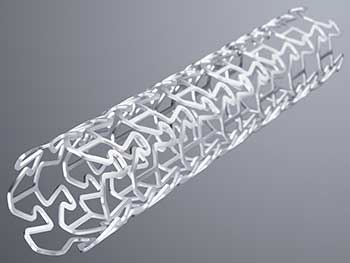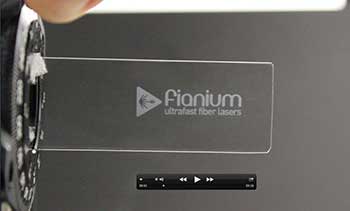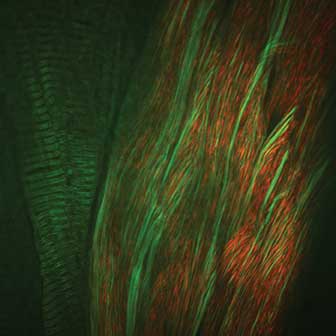Ultrafast fiber lasers are proving less expensive and more comprehensive than traditional alternatives, expanding the range of applications. With cost-efficient, robust design, this group of lasers is advancing in ways that were not practical before.
For lasers, shorter pulses mean more precision and new applications. That’s been true for decades. What’s changed in the last few years is that prices for lasers with pulse widths a picosecond or less are dropping significantly. The price plunge has been pushed along by ultrafast fiber lasers, which are less expensive initially and cost less to operate than alternatives.
As a result, it’s now possible to remove thin films, drill holes and otherwise process materials on a microscopic scale in ways that weren’t practical before. These lasers can also slice and dice transparent materials like sapphire and glass. That further expands the range of possible applications and uses.

A laser-cut bicycle beside a 2 euro coin. Courtesy of Trumpf.
All of this adds up to growth of the ultrafast fiber laser market. Some of which comes at the expense of other laser technologies, according to René Kristiansen, product line manager for aeroPulse Ultrafast lasers at NKT Photonics A/S of Birkeroed, Denmark.
“In a lot of cases you’re replacing UV longer lasers, say nanosecond or lasers, with IR femtosecond lasers. In many cases, a shorter pulse IR laser can do the same job as a UV longer pulse laser used to do,” Kristiansen said.
He noted that ultrafast fiber lasers have a cost-efficient design. One reason is that most major manufacturers have switched over to photonic crystal fiber within the last few years. This approach, according to Kristiansen, is both less expensive and yields inherent beam quality without requiring much tweaking or adjustment. That makes such lasers operationally robust.

A laser-cut stent. Courtesy of Trumpf.
For manufacturers, a benefit of this approach is that it’s possible to take a single design and use it as a platform to quickly spin out multiple variants. In turn, that lowers costs for systems targeting specific applications.
As long as volumes continue to go up, prices for ultrafast fiber lasers will go down. However, future price drops may be somewhat mitigated. Manufacturers tend to increase power or add capabilities to laser designs over time, Kristiansen said. That adds to the cost and counteracts, to a degree, the price reductions generated by increased volume and moving further along the manufacturing maturity curve.
There are a number of ways in which capabilities can be improved. This includes power, either peak or average. There’s also pulse width, wavelength, repetition rates, spectral bandwidth, beam shaping and other possible parameters. Often, adjusting one of these will impact the others and require making a trade-off — if the parameter can be adjusted without a great deal of work at all.

Surface structuring of bulk stainless steel sample using 4- (a), 46- (b), and 415- (c) picosecond infrared lasers. Each dimple was formed by 150 pulses, and the recast lip clearly increases for longer pulses within the picosecond range and demonstrates the increasing heat effects with increasing pulse width. Courtesy of Fianium.
“Changing pulse width can be difficult,” said Tim Gerke, North America sales and marketing manager at Fianium Inc., a subsidiary of Southampton, U.K.-based laser maker Fianium Ltd.
One exception is power. It can be upped by adding more pump diodes or by increasing the length of the fiber run. The first increases the starting point for the laser gain process while the second means there is more gain material and thus more gain, Gerke said.
Repetition rate, another parameter that might be adjusted without impacting others, runs up against outside constraints. Repetition rates could run as high as a few hundred kilohertz, making it theoretically possible to make materials processing faster and throughput higher.
But the beam must be directed to the right spot by a scanner. Many of these are designed with maximum rates of about a megahertz, more than fast enough for Ti:sapphire lasers, an older ultrafast laser technology. However, a megahertz rate of beam movement is too slow to take advantage of the highest repetition rate possible with ultrafast fiber lasers. Development work is underway on what are called polygon scanners, which should bump up the maximum usable repetition rate, Gerke said. He added that in other ways ultrafast fiber lasers offer some significant advantages over the incumbent technology. For instance, Ti:sapphire lasers operate in free-space cavities, get the pulses to the right place by bouncing them off mirrors, and require water cooling. In contrast, ultrafast fiber lasers produce a beam confined to an optical fiber and are air cooled.

Internal scribe in sapphire wafer made using an infrared picosecond high pulse energy laser for singulation purposes. Courtesy of Fianium.
Operating within a fiber means there is nothing to go out of alignment or require adjustment. As for air instead of water cooling, getting rid of water gets rid of one more complicating factor.
Both types of ultrafast lasers enable such applications as drilling holes in foil. The short pulse width makes this possible because the material is vaporized without redepositing, which makes the process cleaner. A key advantage of the ultrafast pulses is that they enable high peak power, which leads to pulses being absorbed by normally transparent materials, Gerke said. Consequently, a rapidly growing application and market is the processing of sapphire and glass found in smartphones.
The short pulse width of ultrafast lasers powers a whole array of applications that involve multiphoton absorption, according to Tim Paasch-Colberg, director of marketing at Toptica Photonics AG of Munich. The company makes ultrafast fiber lasers, with an area of concentration in biophotonics and the life sciences.

Glass slide marked internally using a picosecond high energy laser watermark. The mark is only visible under particular lighting conditions, and the degree of visibility is customizable. Courtesy of Fianium.
Multiphoton absorption is a nonlinear process in which, as the name implies, more than a single photon is absorbed at one time by an atom or a molecule. This is possible when a beam is concentrated into a small volume and its intensity is great enough. Hence, an ultrafast laser with a short pulse width and accompanying high peak power can make it happen. A fiber-based laser offers advantages in doing so because the systems are user-friendly and have a relatively low cost of ownership, Paasch-Colberg said.
The nonlinear nature of the process makes imaging deep within tissue possible because multiphoton absorption only happens in small volumes where the intensity is the highest. For this case, the power of the system can be minimal.
“A lot of applications require only moderate laser output of only a few tens of milliwatts, especially in nonlinear microscopy or industrial measurement,” Paasch-Colberg said.
When materials processing (and not just imaging) is the object, more power is beneficial, he added. An example would be three-dimensional microlithography via two-photon polymerization, a process in which molecules form long chains. Ultrafast lasers enable this because the incoming pulses induce polymerization in a small volume. That spot can be moved as needed.

A two-color image of two-photon excitation done using an ultrafast fiber laser. Courtesy of Toptica.
In these and other applications, reliability is an important feature, with scientists wanting an imaging system to work when desired and industrial users needing the same out of manufacturing systems. Fiber lasers offer a high level of reliability, in part because the technology was adapted from that used in highly dependable telecommunication, according to Paasch-Colberg.
“This results in high stability and maintenance-free operation, combined with a relatively low price in contrast to other ultrafast laser techniques,” he said.
Ultrafast lasers also make the processing of smaller structures possible. This is partly because the heat-affected zone of such lasers is small, with the pulses being too brief for the heat they generate to diffuse very far into the material. The material removed or deposited is likewise miniscule. This leads to greater precision in processing and the creation of smaller structures. A lower-cost ultrafast laser makes such an application more cost-effective.
Sometimes an ultrafast laser does something not possible otherwise, like manufacturing microstructures. But, in other instances the new technology is replacing traditional techniques. For instance, medical devices require marking for identification, such as by the use of a corrosion-free black mark. This is an example of ultrafast lasers replacing conventional techniques, said Max Kahmann, product manager at Ditzingen, Germany-based laser maker Trumpf. Looking toward the future, he noted that simply upping the repetition rate without adjusting other parts of the system, such as the scanner speed, may not yield much of a benefit. One reason is that without fast enough optics the pulses will simply overlap more as the interval between them goes down.
In another example where optics play a key role in performance, Kahmann noted that beam shaping increased the cleaving speed of glass in one application a hundredfold. So, future improvement in ultrafast laser system capabilities might be achieved by changes in components other than the guts of the laser system itself.
As for the continuation of the past trend toward cost reductions, the pace, which has been substantial over the last five or so years, could well accelerate, according to Kahmann, due to applications such as cutting sapphire and other transparent materials for smartphones, a rapidly growing use of ultrafast lasers. Applications like this represent large markets, and therefore offer opportunities to mature the technology. If so, the forecast trajectory outlines future cost trends.
“Especially when the lasers enter very large quantity markets the price reduction will be significantly large, maybe faster and larger compared to the past half-decade,” Kahmann said. “After this large step — currently lots of markets are just doing this step — the price reduction will slow down, but on a much lower price level as we see it today.”